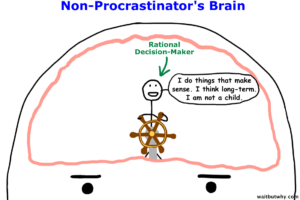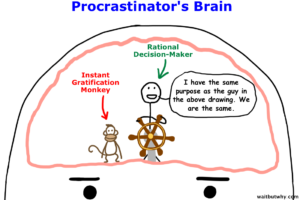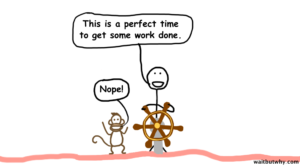Knowing that there are still a bunch of things that should be done: spread out papers, scattered closet, or an email that should be sent, a book that should be read …… and our anxious and disturbed little heart, but we still inwardly imply to ourselves that: do it later, do it tomorrow……
As long as there is no deadline, we can drag it out until the earth explodes.
Procrastination, there is really no way to overcome it?
So how do we break the “spell of procrastination”? In fact, it can be done in five minutes.
1. How does procrastination happen in the brain?
Normal human brain looks like this:
But whenever you want to be quiet and do something meaningful, a “monkey” comes out and takes the wheel and messes with your plans, so you start to let yourself go endlessly.
Ever notice anything different? It seems to be that inside the procrastinator’s head, in addition to Mr. Rational Decision-Maker, there is a pet – the “Instant Gratification Monkey”.
In fact, it would be a cute pet if Mr. Rational Decision-Maker knew how to raise a monkey . Unfortunately, Mr. Rational Decision-Maker is not trained to raise monkeys, so sometimes they start to interfere with him doing what he is supposed to be doing.
Apparently the “Instant Gratification Monkey” only cares about what can bring it satisfaction in the present, completely ignoring future plans. And what about Mr. Rational Decision-Maker? He only knows how to make rational decisions, not how to control the monkey. The result of the struggle with the monkey is that Mr. Rational Decision-Maker becomes increasingly frustrated, and the more he fails, the more we procrastinate. And the more we procrastinate, the more we rebuke our Rational Decision-Maker for not doing his job well.
Inside your brain lives a patron saint who helps you get rid of the monkey, called the “panic monster”, who sleeps most of the time and only appears when you encounter deadline, workplace crisis or some other dilemmas. Also, it is the only thing that monkey is afraid of.
But the “panic monster” tends to appear only when we are in a great crisis, and we cannot hope that it will help us get rid of the “Instant Gratification Monkey”. In this case, we need to take the initiative to find ways to solve the problem of procrastination.
Although common, procrastination should not be underestimated. Severe procrastination can have negative effects on an individual’s physical and mental health, such as strong feelings of self-blame, guilt, constant self-denial and depreciation, and even bring about anxiety and depression. Learning is not good when learning, and playing is not at ease when having fun.
So, how do we change our procrastination? It’s simple: the Five-Minute Rule.
2. Five minutes to overcome procrastination
This method is also called the “5 minute countdown to change” method. This method is simple: you just need to prepare a cell phone or a timer, set a 5-minute countdown, and then tell yourself: from now on, seriously contribute 5 minutes to one thing that you need to complete.
The principle of this method is to lower your own expectations, so that we do not come up to face a huge goal, and the fear of retreat. Five minutes is short enough, you can easily reach the goal, so your motivation will come up.
Let’s take the example of cleaning up a messy room and see how the brain works under the “Five-Minute to save the room” method.
Original inner thoughts: you want to clean up your room? Oh my God, it’s so messy, the bed, the table, the closet all need to be tidied up, too much! This will take at least half a day, forget it, I’ll do it next time when I’m free.
However, inner thoughts under the five-minute rule are like: I only need to finish 5 minutes anyway, it’s too easy, I can’t finish organizing though, it’s okay, I’ve organized anyway, I’ve finished today’s goal, now let’s start!
Then let’s see what happens after 5 minutes, after 5 minutes the room is not completely clean, but it becomes much better than before. And this change stimulates your emotions and your brain immediately thinks: Wow, only 5 minutes to clean a lot, look more comfortable, it does not seem to take a long time to finish tidying up, so why not continue to work hard and tidy up a good deal.
Usually, such a short time of giving will motivate you to keep doing it and get you into that state quickly to get that task done, and the results will often surprise you.
In fact, anything that seems hard, once you get started, the hardest part is already behind you. It’s like my yoga teacher once said: the hardest part of practicing yoga is not the asana, but that moment when you keep standing on the mat daily.
3. Three things need to keep in mind when implementing “Five-Minute Rule”
We have learned this method, so what else needs to be noted? In order to revitalize your brain for immediate action and change, here are 3 things to keep in mind when implementing the “Five-Minute Rule to Change” method.
① Acting now without thinking
To think is to procrastinate, and the more you think, the more your brain imagines the difficulty. Therefore, when you think of something to do, immediately set a countdown and start the task at hand immediately.
② Selecting the most fulfilling part to complete
The secret to the “Five-Minute Rule” is to set goals that are the easiest to accomplish or the most fulfilling part of your overall goal. That is, a high rate of return for a short time of effort. The greater the sense of accomplishment, the more motivated you will be.
③ Five minutes is just a beginning, more efforts are needed
It will take more effort and persistence on your part to complete the entire task in its entirety.
When you use the MYCLNQ app, a professional is just a few clicks away. For online medical consultation, just download our app, speak to a qualified doctor about your problems, and receive the help you need. Contact us today for more information.








